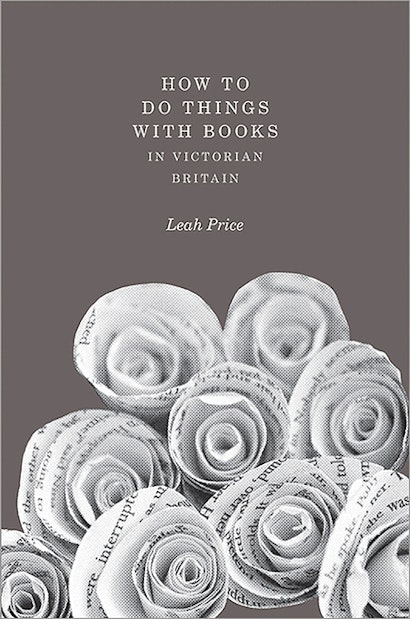"How to Do Things with Books in Victorian Britain alternates between a dense critical unpicking of the ways in which books, reading and writing feature in Victorian fiction and non-fiction, and a strong cultural history of texts, writing and reading in social contexts. The long introductory section offers a detailed study of Victorian novelists' depictions of actions done to or with books, newspapers, or pamphlets."—David Finkelstein, Times Literary Supplement
"Leah Price's point—very cleverly made—is that Victorians did many things with their reading matter other than read it. One of her more striking examples is of fashionable ladies selecting a book to carry on the basis that its binding (silk-board, preferably, never calf) would match their dress that day. . . . Price is very entertaining on men's use of newspapers to create little zones of domestic, noli-me-tangere privacy. . . . Price asks extraordinarily good questions with wider import [and] has uncommonly brilliant things to say about the things Victorians did with their bookish things."—John Sutherland, Literary Review
"Price's work perches at the leading edge of a growing body of investigations into the history of reading."—Chronicle of Higher Education
"[H]ighly enjoyable, well researched and referenced."—Julia Peakman, History Today
"Leah Price has challenged every book historian, librarian, and reader of secular or spiritual scripture to think through the object we fondle or maul and the ways in which it circulates in whole and in pieces through our home and global economies. . . . [T]here's no doubt in my mind that this is a potent intervention in the study of material culture. No one who cares about books should miss handling and reading it."—Robert L. Patten, Review of English Studies
"If you are a literary scholar or a historian whose turf is Victorian Studies . . . you are probably aware of Price's book already. If not, you should add it to your must-read list. If you are interested more generally in the history of the book and reading, especially in connection with current talk about the state and fate of reading—if, for example, you enjoyed Alan Jacobs' The Pleasures of Reading in an Age of Distraction—you should read Price. And if you have noted the revival of 'materialism'—as a creed, so to speak, in which the writer explicitly affirms his or her faith—you will certainly want to get this book."—John Wilson, Books & Culture
"Price's writing is clever and her tone accessible."—Jillian Mandelkern, Library Journal
"[T]ells a compelling 'it-narrative' of its own about the ideological ways in which we handle books and impose them on others."—Valerie Sanders, Times Higher Education
"The printed book, certainly, will always be part of our media environment, although perhaps in unexpected ways. This lends particular interest to How to Do Things with Books in Victorian Britain, by Leah Price, a Harvard English professor. Her study is set in an era when mass production of books had not yet quite eliminated a sense of the book as a peculiar object in its own right, quite apart from its content, or as we say now, the 'text.' The book, Victorian readers knew, had more uses than simply conveying that text."—Philip Marchand, National Post
"Price does an excellent job in explaining the how and why of books during the era by discussing how the readers perceived themselves (men read newspapers to learn world events while women read novels that kept them away from their daily chores), the economical and social status of owning, reading or reciting books and how printed paper was mostly thrown away during the era."—Conny Crisalli, BookPleasures.com
"A most unusual book, one not to be taken lightly."—Frank Shaw, Electric Scotland
"While referencing the works of Anthony Trollope and Charles Dickens in particular, Price pays substantial attention to noncommercial, completely disposable popular literature, especially religious tracts. . . . Price makes print's non-reading or un-reading as meaningful as reading."—Choice
"Sheer originality."—Sarah Murdoch, Toronto Star
"Though rigorously academic, Price's book is also disarmingly humorous, a veritable goldmine of puns and linguistic whimsy."—Los Angeles Review of Books
"Price casts herself as an ethnographer setting out to discover what people and books actually did in the nineteenth century."—Paul Duguid, Threepenny Review
"Each of Price's seven case-studies is as illuminating as it is fascinating."—Simon Calder, Berfrois
"Engaging and incisive . . . constantly entertains the reader with new and surprising material. . . . Price raises a host of questions that reach beyond the Victorian period to contemporary reading practices and values . . . a delight."—Charlotte Mathieson, Open Letters Monthly
"Price opens up fresh avenues of thought about both the history of the book and the history of the novel in the 19th century. . . . How to Do Things with Books is a wonderfully rich work. Written with Price's customary verve and eye for the telling detail, it is a pleasure to read. . . . It brims with intellectual energy, studded with insights to provoke further thought."—Ina Ferris, Wordsworth Circle
"Price is a master of pithy comments that constantly remind us of the parallel but contrasting journeys of novels, tracts, fictional protagonists and real people."—Times Higher Education Supplement
"Extraordinarily rich."—Journal of Victorian Culture
"Strong writing continually spiced with wit. . . . This archaeologist of the imagination . . . continually offers new understandings of matters lying in plain sight but invisible to most of us. Like all first-rate criticism, hers makes us see familiar texts and familiar issues in new ways."—VictorianWeb
"I'm ambivalent about the value for contemporary pedagogy of teaching books only as objects. But there's no doubt in my mind that this is a potent intervention in the study of material culture. No one who cares about books should miss handling and reading it."—Robert L. Patten, Review of English Studies
"Price's study is . . . a timely reminder of the importance of materiality and raises questions about the uses and meanings of books that literary critics and cultural historians need to address. . . . [It] is meticulously researched, intelligently argued and sheds refreshing new light on an underexplored area of Victorian culture. Ultimately, whilst her subjects used their books as doorstops, cheese wrappers and toilet paper, the best thing to do with Price's text is simply to read it."—Bob Nicholson, European Review of History
"How To Do Things With Books is an eye-opening read. . . . This is a rare feat of writing. . . . When was the last time you read an academic book with such perfect gems of sentences you want to buttonhole someone to read them aloud? . . . How To Do Things With Books ends with a gloriously bold challenge. . . . An achievement as poignant as it is important."—Talia Schaffer, Romanticism and Victorianism on the Net
"[M]ost engaging. . . . A fascinating study."—Jon Mee, Recent Studies in the Nineteenth Century
"This deeply researched, deftly argued study delivers a sharp corrective to the 'idealist' conception of reading and the broader 'bookish liberalism' that have guided those histories of the book that take novel reading as the representative way of engaging with books, and assume economic and cultural circulation to be based on operations of individual choice and a will to read. . . . Absorbing, playful, thought-provoking."—Helen Small, Victorian Studies
"[T]he most engaging of the many compelling books I read for this review was Leah Price's How to Do Things with Books in Victorian Britain. A fascinating study, primarily organized around the tension between 'text' and 'book,' Price's volume aims to bring book history and literary criticism into a conversation with each other. . . . Each of these chapters is brilliant in its own way."—Jon Mee, SEL Studies in English Literature 1500-1900
"In this fascinating text, Leah Price ranges widely over territory that is usually carved up into separate fiefdoms by scholars of the history of the book, the history of reading, or some form of literary criticism. . . . Price argues compellingly that the Victorians pre-empted modern-day book historians in probing the meaning and use of books and other printed matter."—Solveig C. Robinson, Victorian Review
"A rich account of the many (often competing) ways in which novels and other print artifacts were read, handled, and circulated, her study provides both a compelling reading of nineteenth-century print culture and a provocative methodological proposal."—Ben De Bruyn, Reception: Texts, Readers, Audiences, History
"Price's book . . . deserves rereading. Or, better still, read it, dream over it, and then pass it along to a friend."—Ben De Bruyn, Reception
"Readers of Victorian Review are likely to find something to inspire or intrigue them in How to Do Things with Books, no matter which disciplines they derive from or which critical or theoretical lines they espouse."—Solveig C. Robinson, Victorian Review
"Price's book is erudite and rich in details and anecdotes, compelling and eminently readable."—Ana-Karina Schneider, American, British and Canadian Studies
"This deeply researched, deftly argued study delivers a sharp corrective to the 'idealist' conception of reading and the broader 'bookish liberalism' that have guided those histories of the book that take novel reading as the representative way of engaging with books, and assume economic and cultural circulation to be based on operations of individual choice and a will to read."—Helen Small, Victorian Studies
"Price's exhilarating work investigates the usual separation of 'text' from 'book,' intellectual inspiration from quotidian object, insightful reader from mere handler. . . . Its argument is wide ranging, subtle, inventive, and consistently surprising. . . . The result is an erudite and dazzling project. . . . How to Do Things with Books read like something of a novel itself—perhaps a Dickens novel, bringing forth a cast of colorful, argumentative characters from disparate walks of life. . . . This summary can hardly convey the detail, wit, richness, and rhetorical sophistication of Price's argument. . . . How to Do Things with Books compels attention from us not only because of its intellectual brilliance but also because it goes to the heart of our own practices."—Ellen Rosenman, Novel
"[Her] book is enormously welcome as an antidote to all of us who have become so enmeshed in analyzing the act of reading that we may have underestimated the history of transmission, book usage and the after-life of books."—Martyn Lyons, European Legacy
"Beautifully written, this superb book gives us a magnificent study of the social lives of books and texts in the Victorian period: their uses as missiles, doorstops, food wrapping, spouse-ignoring devices, and vehicles for individuation, spiritual development, and childlike wonder and delight. A joy to read."—Elaine Freedgood, New York University
"This timely and witty book is more than a shrewd look at the social lives of book-objects and their users, and a reconstruction of the protocols organizing that use. It also provides, gloriously, a new interpretation of the Victorian novel."—Deidre Lynch, University of Toronto
"Price has written an exceptional book of literary history that stretches the boundaries of what literary history means and does. Making her argument through an astonishing range of evidence about the uses of books, paper, and printed material in the nineteenth century, she shows that reading is not the only thing to do with books, either as objects or as historical evidence. A remarkable work."—Nicholas Dames, Columbia University


